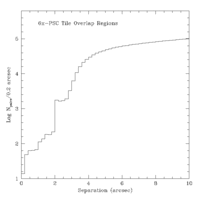Appendix 3. Long Exposure (6x) Scan Databases, Catalogs and Images
6. 6x Catalog Generation
d. Multiple Source Detection Resolution
Stars and galaxies that lie in regions scanned more than once during 2MASS 6x observations may have multiple, independent detections in the 6x WDBs. To maintain photometric uniformity in the 6x-PSC and 6x-XSC, one unique apparition of multiply-detected sources is selected for inclusion in the Catalogs. Catalog scan selection is the first step in this process because it insures that only one scan of each 6x tile is used to generate the catalogs. However, possible duplicate source detections still remain because of the right ascension and declination overlap regions between tiles. The algorithm used to select between multiple detections of 6x point and extended sources in the tile overlaps is similar to the algorithm used for the the All-Sky PSC and XSC that is described in V.4.
Multiple detections are resolved using a purely geometric algorithm to avoid imposing biases. For multiply-detected sources, the apparition that lies farthest from the edges of its respective tile, independent of source brightness or measurement quality, was selected for the 6x Catalogs. Faint sources that toggle above and below the 2MASS 6x detection limit, variable brightness sources, and moving objects such as asteroids and high proper motion stars, may not be detected in all scans that cover their positions.
The 6x multiple detection resolution process is as follows:
- Sources that do not fall in the tile overlap regions, but satisfy the other source selection criteria are always selected for the catalogs.
- Sources that fall in the overlap regions of adjoining tiles, and that satisfy the selection criteria described in A3.6.c, are positionally correlated using a match radius of 2.0´´ for point sources and 5.0´´ for extended sources.
- If a source in an overlap region is detected in only one of the adjoining scans, then that detection is selected for the catalog.
- If there is more than one detection of a source in a correlated group, the minimum of the east-west (dist_edge_ew) and north-south (dist_edge_ns) distances from the source to the nearest respective scan edges is determined for each apparition. The scan edges are defined by the great-circle interpolations between actual reconstructed scan corners. The detection in the group that has the largest value of min(dist_edge_ew,dist_edge_ns) is selected for the catalog.
A graphical example showing how sources at scan edges are parsed for the 6x Catalogs by the multiple detection resolution process is shown in Figure 1 of A3.6.a.
6x source multiple detection resolution differs from that used for the All-Sky (main survey) in how sources in tile overlap regions that were not detected on all available scan are handled. In the main survey, a source was required to lie farther from its scan edges than it would in an adjoining scan, even if the source wasn't detected in the adjoining scan. This was done to minimize sensitivity biases at low flux levels in the overlap regions. Sources that failed this criterion were included in the All-Sky PSC distribution, but were noted by cautionary flagging using the use_src and dup_src catalog parameters.
For the 6x-PSC and 6x-XSC, one detection of a source in an overlap region is always selected regardless of whether or not is was detected in more than one scan. The 6x-PSC and 6x-XSC entries do not contain the use_src and dup_src qualification flags found in the All-Sky PSC and XSC. Instead, multiple detection information is encoded in the spos and sdet parameters that are generated as part of the 6x WDB Merging Process.
Because of the duplicate source handling, the 6x-PSC and 6x-XSC have slightly higher effective sensitivity in the overlap regions since there is more than one opportunity to detect faint sources. The objective of the 2MASS 6x observations is to provide a deeper view of the infrared sky in selected regions. Consequently, improved sensitivity is given more weight than uniformity at faint flux levels for these products than for the All-Sky PSC and XSC. However, caution should be used when performing statistical analyses of source populations fainter than the nominal completeness levels of the 6x observations.
Multiple Detection Resolution Errors in the 6x-PSC
There are approximately 1000 cases in the 6x-PSC where the multiple detections in tile overlap regions were not properly handled and two detections of the same source from different scans were promoted to the Catalog. A histogram of radial separations between pairs of 6x-PSC sources in scan overlap regions is shown in Figure 13. The roll-off in number of pairs with separations less than 5-6" is a result of the effective resolution limit of the 2MASS telescope and camera system. The sharp drop below 2" separation is caused by the 2" match window used in the 6x-PSC multiple detection resolution process, and the the pairs with separations <2" are those that were not properly dealt with by the multiple detection resolution process. A similar population of small separation source pairs exists in the All-Sky PSC, as seen in Figure 14 in I.6.b.ix.
The 6x-PSC duplicate resolution failures were caused by confusion that ensued when one or more of the multiply-detected sources were themselves artificially split within their respective scans because of blending with nearby objects or noise excursions. The sources involved are often faint and/or complex, such as small extended edge-on galaxies that trigger multiple point source detections.
[Last Updated: 2008 March 13; by R. Cutri]
Previous page. Next page.
Return to Explanatory Supplement TOC Page.
